最新文化遗产长城(英语PPT)讲课讲稿
- 格式:ppt
- 大小:1.44 MB
- 文档页数:10

Good morning! Today, I am honored to stand before you to share with you the majestic Great Wall of China, a symbol of our nation's spirit and history.The Great Wall, as we all know, is one of the most magnificent architectural wonders in the world. It stretches over 13,000 miles, winding through mountains, deserts, and grasslands, and has been inscribed on the UNESCO World Heritage List. Today, I will take you on a journey to explore the rich history, cultural significance, and architectural marvels of this awe-inspiring structure.Firstly, let's delve into the history of the Great Wall. The construction of the Great Wall began in the 7th century BC, during the Warring States period. At that time, various states built walls to protect their territories from invasions. Over the centuries, the Great Wall was continuously extended, reconstructed, and fortified. It reached its peak during the Ming Dynasty (1368-1644 AD), when it became a formidable defense against foreign invasions.The Great Wall is not just a physical structure; it is a testament to the determination, courage, and wisdom of our ancestors. The labor force involved in its construction was enormous, with millions of people from all over China contributing to its construction. They endured harsh conditions, extreme weather, and even sacrificing their lives to build this magnificent wall. This shows the unbreakable spirit of our nation, which has withstood countless trials and hardships throughout history.The cultural significance of the Great Wall is immeasurable. It has become a symbol of Chinese national pride and unity. The wall represents the spirit of our ancestors, who fought against external threats and protected their homeland. It also serves as a reminder of the sacrifices made by countless heroes who laid down their lives for the sake of our nation's safety and prosperity.From an architectural perspective, the Great Wall is a masterpiece. The wall was built using a variety of materials, including earth, wood, stone, and brick. The construction techniques employed were highly sophisticated, considering the technology available at that time. Thewall is designed to be an effective defense against invaders, with watchtowers, beacon towers, and battlements strategically positioned. The wall's unique design allows it to withstand harsh weather conditions and maintain its integrity over time.Now, let's take a closer look at the different sections of the Great Wall. The most famous section is the Mutianyu section, located about 70 kilometers northeast of Beijing. This section is well-preserved andoffers stunning views of the surrounding mountains and forests. Visitors can hike along the wall, enjoy the beautiful scenery, and even try their hand at traditional Chinese martial arts.Another popular section is the Badaling section, located about 50 kilometers northwest of Beijing. This section is the most visited partof the Great Wall due to its easy accessibility. The wall here is well-maintained, with stone steps and railings. It provides a great opportunity for tourists to experience the grandeur of the Great Wall.The Great Wall also has a profound impact on the local economy and culture. The wall attracts millions of tourists from all over the world, contributing significantly to the local tourism industry. It has also inspired numerous cultural and artistic expressions, includingliterature, poetry, and art.In conclusion, the Great Wall of China is a marvel of human ingenuityand perseverance. It represents the spirit of our nation, the wisdom of our ancestors, and the beauty of our culture. As we stand here today, we should be proud of this magnificent achievement and strive to protectand preserve it for future generations.Let us remember the words of our great leader, Mao Zedong, who once said, "The Great Wall is the pride of the Chinese people. It has stood for centuries, a symbol of our strength and unity."Ladies and gentlemen, let us cherish the Great Wall, honor its history, and continue to build a great nation together.Thank you.。
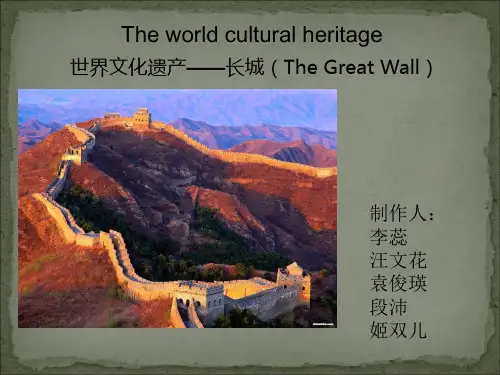

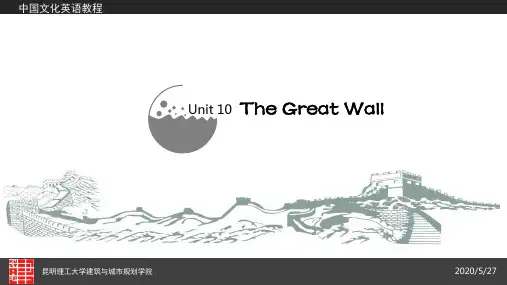


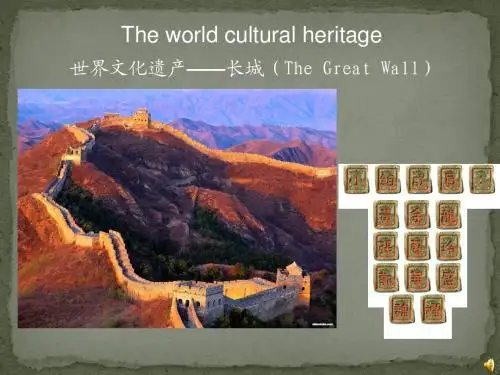
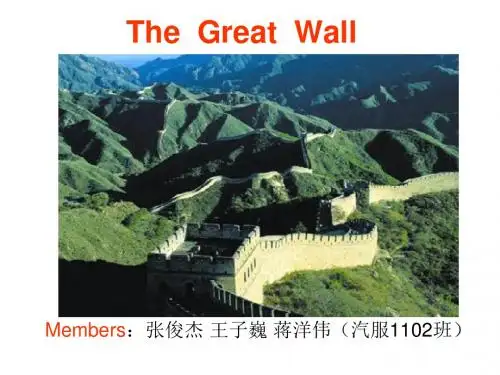

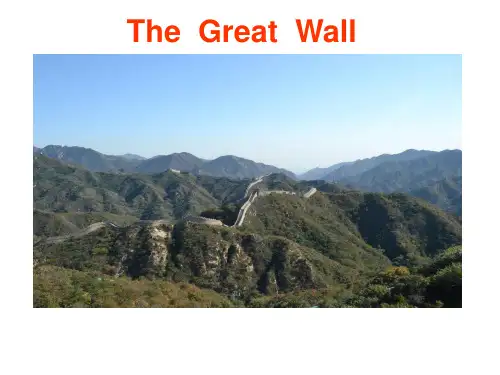

世界文化遗产长城英文介绍The Great Wall of China, a UNESCO World Heritage Site, is a series of fortifications made of stone, brick, tamped earth, wood, and other materials. It stretches across the northern borders of China, spanning approximately 13,171 miles (21,196 kilometers) from east to west. The construction of the Great Wall began as early as the 7th century BC and continued for centuries, with various dynasties adding to and fortifying the wall. The purpose of the wall was to protect the Chinese states and empires against the raids and invasions of the various nomadic groups of the Eurasian Steppe.The Great Wall is not a continuous wall but rather a collection of walls and fortifications built across different time periods. It features watchtowers, barracks, garrison stations, and signaling capabilities, making it a complex and sophisticated defense system. The most famous sections of the Great Wall, such as Badaling and Mutianyu, are popular tourist destinations, offering visitors theopportunity to walk along and experience this iconic symbol of Chinese civilization and military prowess.In addition to its historical and architectural significance, the Great Wall of China is also a symbol of Chinese national pride and unity. It has been the subject of numerous poems, paintings, and cultural works throughout Chinese history, and it continues to be a source of inspiration and fascination for people around the world. The Great Wall remains one of the most recognizable and enduring symbols of ancient China and is a testament to the ingenuity and determination of the people who built it.。